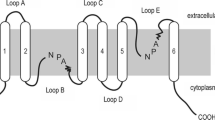Synopsis
The localization of carbonic anhydrase activity in the vertebrate nephron has been examined with particular reference to the proximal tubule and collecting duct. In all species studied, activity was present in the proximal tubular epithelium. In the pigeon and turtle, distinctive and similar patterns of staining were observed in the glomerulus and first portion of the proximal tubule. In the rat and rhesus monkey, the entire proximal tubule exhibited activity; in these species it has been shown previously with micropuncture techniques that there is a high absorptive capacity of this nephron segment for bicarbonate. In contrast, large portions of the dog proximal tubule were inactive; similar studies in this animal have shown tubular concentrations of bicarbonate only slightly lower than plasma levels. In the rat and dog, the entire length of the collecting duct was diffusely and intensely active; in contrast, pigeon collecting duct showed no activity. An alternating pattern of inactive and intensely active cells was observed in the collecting ducts of the toad, turtle, rabbit and monkey. A similar pattern has been described in the turtle and toad bladder, tissues utilized forin vitro studies of ion transport and H+ secretion.
Similar content being viewed by others
References
Bennett, C. M., Brenner, B. M. &Berliner, R. W. (1968). Micropuncture study of nephron function in the rhesus monkey.J. clin. Invest. 47, 203–16.
Clapp, J. R., Watson, J. F. &Berliner, R. W. (1963). Osmolality, bicarbonate concentration and water reabsorption in proximal tubule of the dog nephron.Am. J. Physiol. 205, 273–80.
Giebisch, G., Windhager, E. E. &Pitts, R. F. (1960). Mechanism of urinary acidification: InBiology of Pyelonephritis (eds. El. Quinn and E. H. Cass), pp. 277–87. Boston: Little Brown.
Gottschalk, C. S., Lassiter, W. E. &Mylle, M. (1960). Localization of urine acidification in the mammalian kidney.Am. J. Physiol. 198 581–5.
Hansson, H. (1967). Histochemical demonstration of carbonic anhydrase activity.Histochemie 11, 112–28.
Hansson, H. (1968). Histochemical demonstration of carbonic anhydrase activity in some epithelia noted for active transport.Acta physiol. scand. 73, 427–34.
Hierholzer, K. (1961). Secretion of potassium and acidification in collecting ducts of mammalian kidney.Am. J. Physiol. 201, 318–24.
Huber, G. C. (1917). On the morphology of the renal tubules of vertebrates.Anat. Rec. 13, 305–39.
Longley, J. B. &Fisher, E. R. (1954). Alkaline phosphatase and the periodic acid-Schiff reaction in the proximal tubule of the vertebrate kidney.Anat. Rec. 120, 1–22.
Maren, T. H. (1967). Carbonic anhydrase: Chemistry, physiology and inhibition.Physiol. Rev. 47, 595–781.
Myers, C. E., Bulger, R. E., Tisher, C. C. &Trump, B. F. (1966). Human renal ultrastructure IV Collecting duct of healthy individuals.Lab. Invest. 15, 1921–50.
Pollak, V. E., Mattenheimer, H., DeBruin, H. &Weinman, K. (1965). Experimental metabolic acidosis: The enzymatic basis of ammonia production by the dog kidney.J. clin. Invest. 44, 169–81.
Rector, F. C., Jr. (1964). Micropuncture studies on the mechanism of urinary acidification. InRenal Metabolism and Epidemiology of Some Renal Diseases, pp. 9–31. York, Pennsylvania: Maple Press.
Rector, F. C. (1971). InRenal Secretion of Hydrogen in the Kidney, Vol. III (eds. C. Rouiller & A. F. Muller), pp. 209–52. New York and London: Academic Press.
Rosen, S. (1970). Localization of carbonic anhydrase in trasporting urinary epithelia.J. Cytochem. Histochem. 18, 668–70.
Rosen, S. (1972). Localization of carbonic anhydrase activity in turtle and toad urinary bladder mucosa.J. Cytochem. Histochem., In press.
Schwartz, J. H. &Steinmetz, P. R. (1971). CO2 requirements for H+ secretion by the isolated turtle bladder.Am. J. Physiol. 220, 2051–7.
Schwartz, J. H., Rosen, S. & Steinmetz, P. R. (1972.) Carbonic anhydrase function and the epithelial organization of H+ secretion in the turtle bladder.J. clin. Invest. MS. submitted for publication.
Smith, H. W. (1929). The inorganic composition of the body fluids of the Chelonia.J. biol. Chem. 82, 651–61.
Sperber, I. (1960). InExcretion in Biology and Comparative Physiology of Birds, Vol. I (ed. A. J. Marshall), pp. 469–72. New York: Academic Press.
Steinmetz, P. R. (1967). Characteristics of hydrogen transport in urinary bladder of water turtle.J. clin. Invest. 46, 1531–40.
Trump, B. F. &Bulger, R. E. (1968). InMorphology of the Kidney in Structural Basis of Renal Disease (ed. E. L. Becker), pp. 1–92. New York: Harper & Row.
Ullrich, K. J., Eigler, F. W. &Pehling, G. (1958). Sekretion von Wasserstoffionen in den Sammel rohren der Saugetieniere.Arch. Ges. Physiol. 267, 491–6.
Author information
Authors and Affiliations
Rights and permissions
About this article
Cite this article
Rosen, S. Localization of carbonic anhydrase activity in the vertebrate nephron. Histochem J 4, 35–48 (1972). https://doi.org/10.1007/BF01005267
Received:
Issue Date:
DOI: https://doi.org/10.1007/BF01005267




